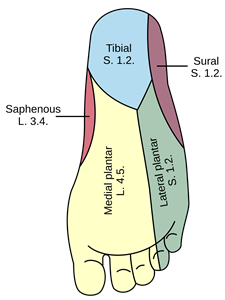How This Helps
This condition can affect a wide range of people in the athletic and non-athletic populations. Obesity is present in up to 70% of patients with PF.1 In the non-athletic populations there is a strong association between increased body mass index (BMI) and PF. 1 While, in the athletic populations there is no correlation between PF and weight, height or BMI. 1 Other risk factors include the presence of heel spurs, foot type, limited ankle range of motion and prolonged standing.
Instructions
What causes Plantar fasciitis (PF)? Plantar fasciitis is a common foot condition that causes heel pain and often requires professional care. PF is the most common cause of chronic pain beneath the heel and makes up 11-15% of the foot symptoms requiring professional care among adults. 1 It is estimated that 1 in 10 people will develop PF in during their lifetime.1 PF can be particularly difficult to deal with due to the pain that it causes during standing and walking activities.
The diagnosis of Plantar Fasciitis is usually clinical and rarely needs to be further investigated. 1 PF can be diagnosed through a physical exam. Imaging studies are typically not necessary for the diagnosis of PF. 1 The typical presentation of someone experiencing PF include complaints of pain on the inside of the heel which is most noticeable with initial steps after a period of inactivity and usually lessons with increased level of activity during the day but then will tend to worsen toward the end of the day. 1 Symptoms may become worse following prolonged standing or walking. On clinical exam the patient will likely have a tight Achilles tendon which is found in almost 80% of cases. 1 The clinical course for most patients is resolution of symptoms within a year. 1
Physical therapists can treat this condition through the use of modalities, massage/manual techniques stretching and strengthening. Modalities that can be used at home are heat and ice. Heat can be used at home to reduce muscle tightness and ice can be used for pain and inflammation. The gastrocnemius muscle as well as the Achilles tendon can be tight and heat can sometimes help to relieve the tightness. Stretching may be done on the calf or the plantar region of the foot. A calf stretch is performed with the patient standing with staggered legs facing toward a wall with both hands stretched out.1 The key is to keep both feet forward and the heels down on the ground to get an adequate stretch. Plantar fascia stretching itself can also be performed. Orthotics may also be recommended depending on foot type. Heel pads can also be considered. Taping can provide short term pain relief and may improve standing and walking tolerance short term. Night splints can be used to keep the foot in a neutral position over night and for stretching the calf and plantar fascia during sleep. 1 Resting has also been recommended to decrease the amount of pressure on the heel in order to decrease pain. Physical therapists can use manual techniques with varying massage techniques to decrease tightness, increase mobility and improve blood flow to the area in order to decrease pain.
If conservative management fails more invasive procedures may be considered which will be at the recommendation of the treating physician. The bottom line is if you are experiencing any symptoms that are consistent with the diagnosis of PF it is important to follow up with your physician in order to begin treatment so that the condition does not become chronic and can be appropriately treated.
Reference: 1. J Res Med Sci. 2012 Aug; 17 (8): 799-804







